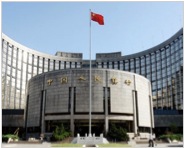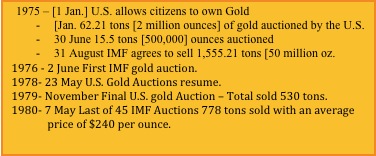"The U.S. and Europe have always suppressed the rising price of gold. They intend to weaken gold's function as an international reserve currency. They don't want to see other countries turning to gold reserves instead of the U.S. dollar or euro. Therefore, suppressing the price of gold is very beneficial for the U.S. in maintaining the U.S. dollar's role as the international reserve currency. China's increased gold reserves will thus act as a model and lead other countries toward reserving more gold. Large gold reserves are also beneficial in promoting the internationalization of the renminbi [yuan]."
 Chinese Gold Accumulation
Chinese Gold AccumulationIn the five years from 2003 to 2008, China added 454 tons of gold to their reserves. They amassed these reserves in a government agency which handed over the extra tonnage to the People's Bank of China in 2008. We believe that they continue this policy of using a non-central bank agency to gather gold for their reserves. If they do stick to this policy, they should make their next announcement in 2013. The volumes of gold added up to 2008 could be seen as adding 91 tons a year since 2003 or, more likely, adding the growing domestic gold production directly to their stockpile. If that is the case then we expect an additional amount of at least 2,000 tons to be passed from the gold buying agency to the People's bank of China.
With the government licensing so many international banks to import gold to China, Chinese citizens are buying directly from these banks and therefore the international market. The accumulation of gold reserves in China is therefore a total of the two sources. So don't be surprised if China is holding [citizens plus central bank] around 5,000 tons or more by 2013. This is still a small amount compared to their dollar reserves. But central banks don't look at gold in quite the same way as mere mortals.
Gold Price Suppression
The Chinese belief that the U.S. and Europe have always suppressed the rising price of gold cannot be refuted reasonably. The gold sales by the U.S. and then in the seventies the gold sales by the I.M.F. were direct attempts to squash the gold price in the pretence that gold would be sold out of the system.
In 1978 the Second Amendment of the IMF Articles was intended to delete gold from the international monetary system. The amendment followed the failure of previous attempts to establish a new international monetary system. In particular these included the failure of European countries to force the United States to either settle its deficit in gold, or else devalue the dollar against gold. This Second Amendment of the Articles barred members from fixing their exchange rates to gold and removed the obligation on members to conduct transactions in gold at the official gold price.
Not only did the United States refuse to keep gold in the system, it then led a crusade against gold (while being careful to keep a very large strategic stock of gold in its own reserve, sealed off from the outside world).
Symbolizing the plan to drive gold out of the system, the IMF was instructed [the U.S. held the deciding vote in the I.M.F.] to dispose of 50 million ounces of its gold stock of 153 million ounces. It achieved this partly by sales to the market and partly by giving some gold to members in relation to their quotas.

Ironically, this exercise had the effect of spreading gold much more widely through the international community than ever before, and gave many countries a new interest in the gold market. Few countries showed any inclination to sell the gold handed to them, and in the vast majority of cases it continues to sit on their books. The later sales of gold were snapped up so fast that the U.S. realized that they would really have to sell all their gold, if they were to succeed, but they themselves valued gold so much they halted those sales.
Accelerated Sales
From the mid-eighties central banks took a different 'tack' on their anti-gold campaign. Just as there is not greater patriot than, "he who commits you to his cause", the anti-gold campaign then allowed mining companies such as Barrick, to borrow central banks gold then sell it forward for around five years at a time when gold prices were falling. The mining companies then financed their own production, getting the gold price up-front plus the interest accruing for the five years [the Contango] and delivering their subsequent production back to the central banks. This caused an acceleration on the amount of gold produced by mining and swamped the gold market so much that the price of gold fell from $850 an ounce in the eighties to $275 by the end of the nineties.
1999: The First Break in the Anti-Gold Campaign
The first fracture in the developed world's anti-gold campaign came when the Governing Council of the European Central Bank decided that the national central banks participating in the euro area should include gold in the initial transfer of foreign reserve assets to the European Central Bank. The transfer was to take place on the first day of 1999, the launch date of the euro as a single currency. This action confirmed the importance of gold as a reserve asset. The Governing Council decided the initial transfer of foreign reserves would be to the maximum allowed amount of €50 billion. This figure was adjusted downwards by deducting the shares of those E.U. central banks which would not participate in the euro area at the outset i.e. to a total of approximately €39.46 billion. The E.C.B. agreed that 15% of this initial transfer should be in gold. Gold clearly enhanced public confidence a point made in the 2009 Chinese cable [above]. Despite the gold sales under the gold sale agreements, gold's share of the ECB's total reserves has grown considerably since then due to the sharp increase in the gold price. As at September 2010 the E.C.B. had 26% of its reserves in gold.
When the "Washington Agreement" was instituted in the year 1999 it attended the launch of the Euro as Europe's currency. The "Washington Agreement" plus the subsequent European Central Bank Agreements were to sell 'up to' a ceiling level of 400 or 500 tons of gold and was intended to establish the euro as a major currency, without competing with gold. Like the U.S. sales of gold, there was no intention to get rid of gold as an important reserve asset, hence the strictly limited sales and the retention of the bulk of gold reserves in the different national foreign exchange and gold reserves. In it, they stated that gold would remain an important element of global monetary reserves, and agreed to limit their collective sales to 2,000 tons over the following five years, or around 400 tons a year. They also announced that their lending and use of derivatives would not increase over the same five-year period. (The signatory banks later stated that the total amount of their gold they had out on lease in September 1999 was 2,119.32 tons.)
The signatory banks accounted for around 45% of global gold reserves. In addition a number of other major holders—including the U.S., Japan, Australia, the IMF and the BIS, either informally associated themselves with the Agreements or announced at other times that they would not sell gold. Including these, the proportion of gold reserves covered by the Agreement or a similar announcement rises to around 85%.
The announcement of the Agreement came as a major surprise to the market. It prompted a sharp spike in the gold price over the following days, but it also removed much of the uncertainty surrounding the intentions of the official sector. Once the markets had adapted to it, a major element of instability had been effectively removed with the introduction of greater transparency.
The Chinese are absolutely correct in believing that the U.S. and Europe have suppressed the price of gold! The evidence is glaring at us through history.
Part 2
For Subscribers Only
GoldForecaster.com
SilverForecaster.com
Legal Notice / Disclaimer
This document is not and should not be construed as an offer to sell or the solicitation of an offer to purchase or subscribe for any investment. Gold Forecaster - Global Watch / Julian D. W. Phillips / Peter Spina, have based this document on information obtained from sources it believes to be reliable but which it has not independently verified; Gold Forecaster - Global Watch / Julian D. W. Phillips / Peter Spina make no guarantee, representation or warranty and accepts no responsibility or liability as to its accuracy or completeness. Expressions of opinion are those of Gold Forecaster - Global Watch / Julian D. W. Phillips / Peter Spina only and are subject to change without notice. Gold Forecaster - Global Watch / Julian D. W. Phillips / Peter Spina assume no warranty, liability or guarantee for the current relevance, correctness or completeness of any information provided within this Report and will not be held liable for the consequence of reliance upon any opinion or statement contained herein or any omission. Furthermore, we assume no liability for any direct or indirect loss or damage or, in particular, for lost profit, which you may incur as a result of the use and existence of the information, provided within this Report.



























































